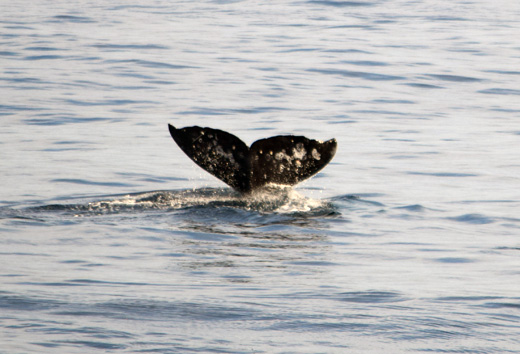
Story and photos by Donald H. Harrison and Shor M. Masori


SAN DIEGO – Even before one comes aboard the Adventure Hornblower for a 3 1/2 -hour whale-watching tour, one begins learning about the California Gray Whale, which is the sightseeing vessel’s quarry. Yellow-shirted volunteer “whalers” from the San Diego Museum of Natural History – known familiarly as “The Nat” – tell visitors as they queue to board that the whales we are soon to see are in the midst of their southbound migration, having come all the way from the Arctic Circle and still having a long way to go to reach their calving grounds in the lagoons along Mexico’s Baja California Sur peninsula.
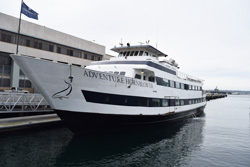
The first part of our journey is at the required slow speed of 5 knots per hour through San Diego Bay, where a guide over the loudspeaker points out familiar sights and ships. Over there, on our port (left) side is the aircraft carrier USS Theodore Roosevelt, named for the 26th U.S. President. Next, we see the state tall ship Californian enjoying the balmy day. Farther along is the Stars & Stripes, the America’s Cup-winning racing boat made famous by San Diegan Dennis Conner. And if we squint our eyes, we can see FA-18 jets parked in a row at the North Island Naval Air Station, one of the last landmarks before we pass the Zuniga Jetty, taking us out into the Pacific Ocean, where the swells remind us of a gentle roller coaster.
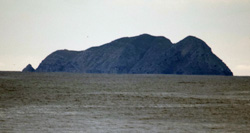
Because of the way the lone entrance and exit to San Diego Bay is angled, our boat’s direction as we enter the Pacific Ocean is southbound, just a few miles above the U.S.-Mexican border. Ahead of us, we can clearly see Los Coronados (The Crowns) the four islands in Mexican waters that were named by Spanish explorer Sebastian Vizcaino in 1602. However, our motor yacht makes a turn to the starboard (right), heading us out on a westbound course, to a point between three and four miles from the San Diego coast. Here, announces our captain, is the area where we are most likely to see some whales in the midst of their journey. Gray Whales have two side-by-side blow holes, so when they expel air from their lungs through these orifices, the vapor caused by their warm breath hitting the cold ocean air forms a characteristic V-shaped spout. Passengers were told to watch for these spouts, and also to scan the ocean surface for flat whale-sized depressions, which are indicators of the large mammals swimming nearby under the water.
Some passengers hugged the rails of our three-deck, 151-foot long, 32-foot wide motor yacht, while others stayed seated indoors and outdoors as the 94-gross-registered-ton ship slowly maneuvered to the whale route. At last, a whale was spotted off the port bow, and nearly everyone moved to that side of the 24-year-old steel motor yacht to get a better look. Our captain said that the whale we were seeing appeared to be either a calf (new born) or a juvenile.
Amid the clicking of many cameras, we watched as the young whale’s back came out of the water – much as a human swimmer’s back does in the “butterfly” stroke – and then disappeared to be replaced moments later by its tail—or fluke—that propelled the California Gray in a downward direction. Seeing the whale’s tail is interesting, but not nearly so exciting as seeing a relatively rare instance of the whale jumping out of the water – or breaching – so that you can see its face and upper body. The two whales we spotted on our journey were not so inclined; they seemed intent on immigrating from United States waters to Mexico waters without further ado.
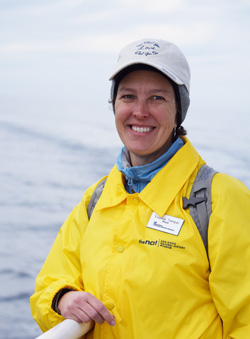
Our captain decided to abandon these two whales and turn in a northbound direction towards La Jolla in an unsuccessful attempt to spot more playful California Gray Whales. While the boat thus was headed to a new position, I had the opportunity to chat with Natural History Museum volunteer Yvonne Tempel, who was taking a break from her job as an elementary school teacher to work as a “whaler.” In true Passover night fashion, I asked what makes this whale different from all other whales, and she replied that before its migration, when it is up in the Arctic, the California Gray Whale swims on its side along the ocean bottom and scoops into its mouth all the goodies it can find in the silt. You can imagine the underwater furrows created by such feeding habits. The whale’s baleen strains the huge amount of material, keeping out rocks and sand. The whale uses its tongue to convey massive amounts of yummy anthropods, measuring about 2 centimeters each, off the baleen and down its gullet.
Tempel told me that there are approximately 7,000 California Gray Whales in the Pacific Ocean, and that “they stay pretty close to North American shores, about three to six miles when they migrate south and within nine miles when they migrate north.”
The whales stay in the Mexican lagoons approximately six to eight weeks, although it may be longer for mothers with newborns. Neither on the roundtrip between the Arctic and Mexico, nor in the lagoons where they concentrate on mating and birthing is it typical for the California Gray Whale to eat. It continues to fast until it returns to the Arctic in the summer.
During the summer feeding season, the California Gray Whale gorges itself, Tempel said. “A 35-ton whale can consume 4,200 pounds of food per day – which is about 6 percent of its body weight.”
Climate change has its impact on the California Gray Whale, Tempel told me. Sometimes because of weather conditions, to find food, “they have to go farther north. As they are coming south, sometimes they have their babies sooner, before they get to Mexico, because they have farther to travel. Also, sometimes they don’t leave as early because the ice doesn’t form as early.”
The journey for the whales and calves is very dangerous around California’s Monterey Peninsula because that is where Orcas like to congregate and “they like to eat the baby Gray Whales.”
Because our January 13 cruise started at 1:30, it didn’t end until 5 p.m., plenty of time to see a beautiful sunset as we rounded Point Loma to enter San Diego Bay.
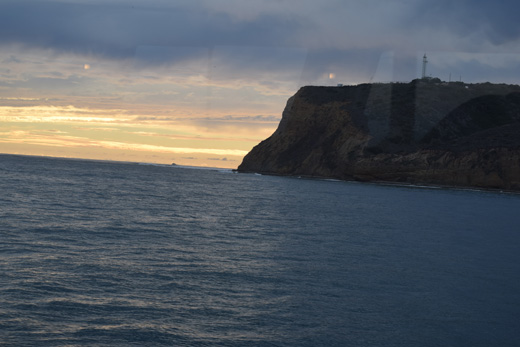
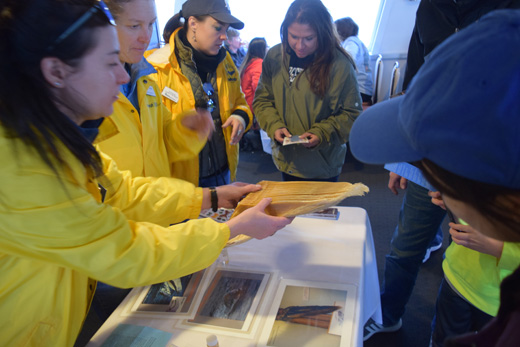
Towards the end of the cruise, when we were safely back inside San Diego Bay, Tempel and four other volunteers from the “Nat,” exhibited some vertebrae and a baleen of a Gray Whale. They also showed a barnacle and the lice that make their homes on the whale’s back – the barnacle simply to hitchhike a ride, while the lice feed off the whale’s skin.
The general admission price is $43 for this 3 ½ hour cruise that leaves at either 9:30 a.m. or 1:30 p.m. from Pier 2 at 970 North Harbor Drive, San Diego. Tickets may be reserved by phoning (619) 686-8715. The Adventure Hornblower, one of seven ships in Hornblower’s San Diego fleet, is also used for dinner cruises, and has a seating capacity of 550 over its three decks. In addition to San Diego, Hornblower has its boats homeported in San Francisco, Berkeley, Sacramento, Marina del Rey, Long Beach, and Newport Beach, California, as well as in New York City.
*
Harrison is editor and Masori is a staff photographer of San Diego Jewish World. They may be contacted respectively via donald.harrison@sdjewishworld.com and shor.masori@sdjewishworld.com